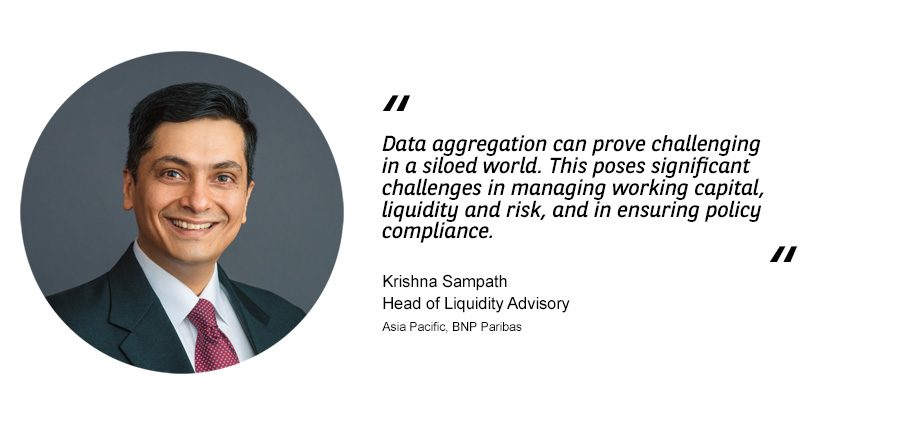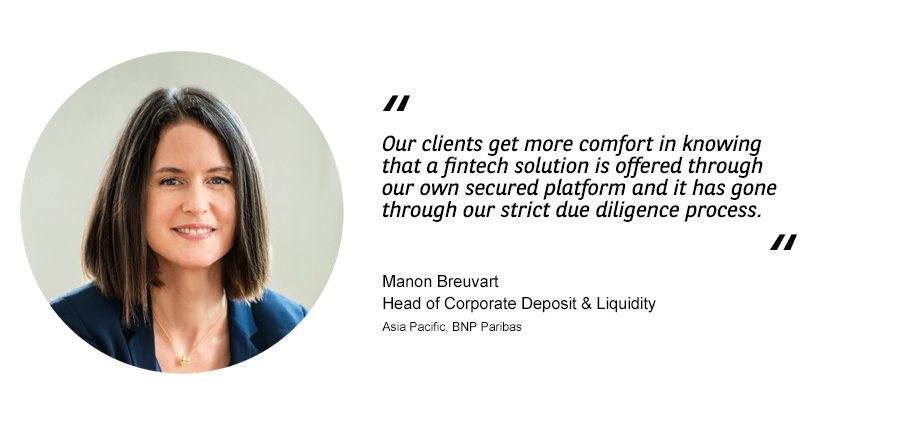In today’s digital age, corporations and financial institutions are awash with
more data than ever before. In fact, 90% of the world’s data has been created in the last two
years.
Increasing automation and digitisation of the cash conversion cycle that
includes everything from payments and receivables to supply-chain management
are driving exponential growth in the 3Vs of big data: volume, variety and
velocity.
How are
corporate treasurers dealing with this flood of information? Do they possess
the right tools to analyse and act on it? How are banks helping treasury teams
use data more efficiently?
Research
by Forrester indicates that between 60% and 73% of all
data within an enterprise is not used for analytics. This is despite the fact that
more companies are talking about big data, using technology to capture more
data and acknowledging the value of this information. At the recent BNP Paribas
Asia Pacific Treasury Board meeting in Singapore, treasurers at leading
corporates in Asia Pacific revealed that most treasury teams are playing
catch-up when it comes to data mining and analysis. They are under increasing
pressure to use data to improve cash forecasting and risk management, and to
minimise and prevent fraud. While technologies such as artificial intelligence
(AI) and blockchain show promise, most companies are still in the early stages
of their digital journey.
How treasurers currently use data
Data usage varies significantly across companies. Some treasurers mainly use data for compliance purposes and tax analysis, but not for cash management or liquidity optimisation.Others have been primarily using data to manage their foreign exchange (FX) exposure. Overall, there is recognition that treasuries can benefit significantly from actionable data analytics to improve efficiency.
Treasurers recognise they need to catch up with their business peers, other businesses and divisions such as Sales and Procurement, who have been using data analytics to identify business opportunities for a few years already. Some large treasuries have embarked on complex transformation projects that involve consolidating data under a single enterprise resource planning (ERP) system and are hiring data specialists to build their analytics capabilities.
Data use: key challenges and risks
Despite its abundance, timely data isn’t always available in readily useable forms, primarily because of the lack of standardisation amongst the key providers, e.g. banks and regulators. “Data aggregation can also be challenging because information is often siloed in different ERPs, data servers and shared service centres – even spreadsheets. This poses significant challenges in managing working capital, liquidity and risk, and in ensuring policy compliance,” explains Krishna Sampath, Head of Liquidity Advisory for Asia Pacific at BNP Paribas.
Information compiled from various sources such as banks and regulators in different jurisdictions varies in standardisation and frequency, making it hard to create uniformity for ease of cash forecasting and reconciliation. For example, the reconciliation of customer invoices and associated collections continues to be a major pain point that hinders corporates seeking to optimise theirworking capital and liquidity requirements.
The absence of data-sharing amongst various corporate functions and divisions severely limit treasurers’ ability to assess their company’s liquidity positions. The lack of timely data and forecasts creates vulnerabilities such as the inability to address liquidity shortages rapidly. Without improving liquidity management, companies find it hard to reduce interest expenses and debt, and to deploy excess cash profitably.
Timely data analytics is increasingly crucial for corporates amid constantly evolving sanctions regimes, breaches of which could have significant financial and reputational impact. Global treasuries in particular deal with voluminous cross-border payments and must ensure these adhere to treasury and corporate governance policies. Risk management requires immediate alerts on any deviation so that suspect transactions can be investigated and remedied.
A role for banks: a safer entry into the data labyrinth?
Banks have recognised the importance of digitisation, incorporating data analytics and embracing a data-driven approach, in many cases by collaborating with financial technology (fintech) firms. This hybrid approach allows clients to benefit from innovative products with faster time-to-market cycles that are secured by banks’ security platforms, which are compliant with data privacy and data-sharing regulations.“We have noticed that our clients get more comfort in knowing that a fintech solution is offered through our own secured platform and it has gone through our strict due diligence and risk management reviews,” said Manon Breuvart, Head of Corporate Deposit & Liquidity, Asia Pacific, BNP Paribas. Treasurers are looking to banks to help them successfully navigate the data labyrinth and conundrum.
For example, BNP Paribas has partnered with Cashforce, a next-generation digital cash forecasting and treasury management solution focused on analytics, automation and integration. The platform integrates seamlessly with clients’ ERP, accounting and banking systems, ensuring the use of receivables and payables data for accurate cash forecasting. An embedded simulation engine allows for scenario modelling to determine the impact on future cash positions and working capital requirements. The next step is to add AI to the platform to increase its predictive forecasting capabilities.

To free up working capital and improve receivables management, BNP Paribas has collaborated with a fintech to co-create a solution with a client that allows for the effective capture and management of data to automate the reconciliation of invoices and collections. This eliminates the largely post-facto manual reconciliation process, resulting in significant efficiency gains with reduced errors and a shorter cash-conversion cycle. The corresponding faster release of credit limits enables clients to book more sales and reduce outstanding inventory.
BNP Paribas has also co-created a unique data analytics dashboard that helps improve operational treasury management tasks by allowing treasurers to get complete visibility to their account structures including mandates and usage. This unified view allows treasurers to readily view and access actionable data on payments and collections and helps improve the cash conversion cycle. Important treasury key performance indicators can be monitored and data can be easily downloaded for internal reporting. Co-creation allows us to offer tailored solutions to build the treasury of tomorrow based on current and evolving needs and priorities of our clients.
